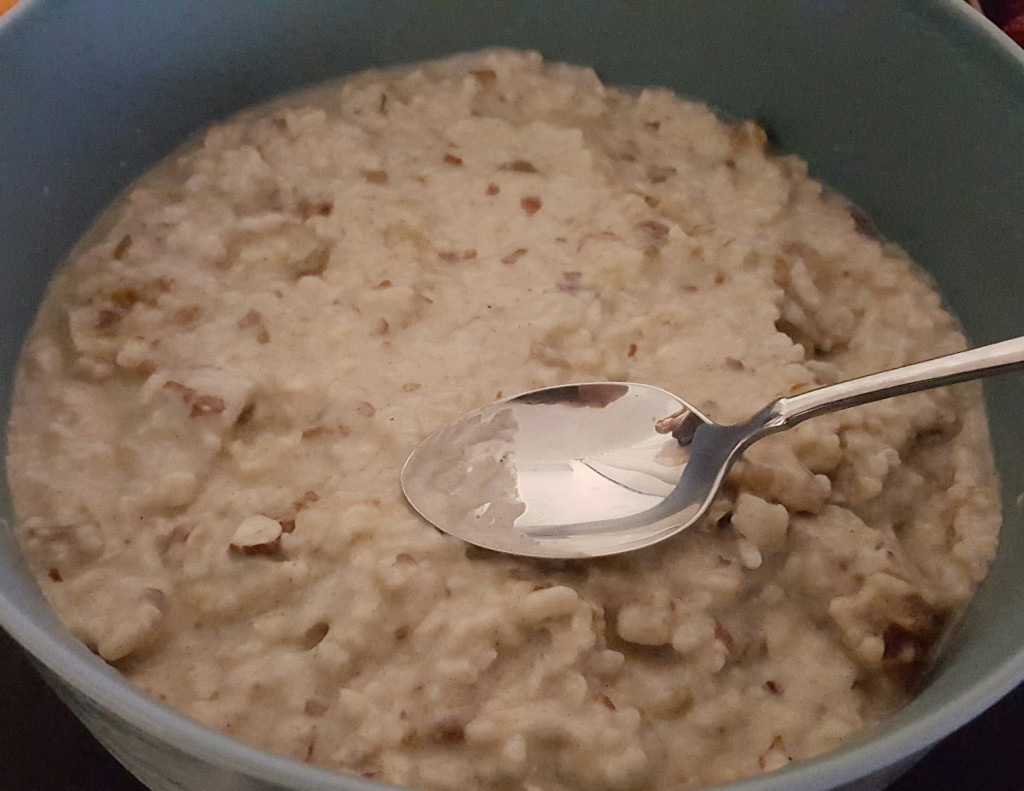Indian Rice Pudding, Takes 2 and 3
My first take on Indian rice pudding featured full-on whole milk, and it was good. There were, however, some things I was definitely looking to improve or at least investigate. So now it’s time for the results of Indian rice pudding, Takes 2 and 3.
I have several friends who can’t do a lot (or any) dairy, so one of the things I wanted to determine was whether I could make a satisfying Indian rice pudding without it. In Take 2, I tried coconut milk (full fat). The flavor was good, but the problem with coconut milk, apparently, is that the fat separates. Just as my slow cooker lamb shoulder with cinnamon red wine curry developed a thick layer of fat after a night in the refrigerator (totally expected with meat, and it was easy to scoop off), so did my Indian rice pudding with full fat coconut milk. Well, it wasn’t as thick or universal, but it also wasn’t as easy to remove.
Now coconut fat is obviously considerably less bad for you than a giant hunk of beef or lamb fat, and it didn’t affect the flavor of the dish, but it’s still pretty unsightly when you have this fat ring. Looking ahead to my annual Oscar party, it certainly wasn’t going to be attractive. Maybe the trick was simply to take off the entire top layer of the dish, but that still left me thinking this wasn’t the final answer.
For Indian rice pudding, Take 3, I tried 5 cups of unsweetened almond milk and a single cup of light (i.e. low fat) coconut milk. Jackpot. The flavor was there (I chop up almonds to put in the dish anyway), with the light coconut milk giving it a little extra richness without the full-on fat and the resulting fat layer.
There were a few other areas of experimentation over the course of the three takes. Originally, I tried half sugar and half dates (Aarti Sequeira’s recipe just uses sugar). By Take 2, that had evolved to all dates (from amazing organic provider Bautista Family Date Ranch, of course!) and no sugar. Much healthier (dates are a particularly good source of fiber) and sweet enough, but not cloyingly so. Also, in Take 1, I used vanilla. In Take 2, I tried rose water. Frankly, I wasn’t a huge fan, and ended up throwing in a few drops of vanilla. By Take 3, I was back to vanilla all the way. And while my Take 1 used long-grain rice by necessity (i.e. didn’t feel like running out to the store to buy more rice), Takes 2 and 3 featured basmati rice. But I personally don’t think that made a difference either way; they’re pretty similar.
What about the cooking time? I did feel that Indian rice pudding, Take 1 was pretty thick. I tried to keep an eye on that in Take 2, though that still felt thick. I stopped reducing it on the stove a little earlier in Take 3; the reality is that it’s going to thicken in the refrigerator as it cools. In any case, what I got in Take 3 felt right. You have to eyeball it, but as Aarti Sequeira says, think porridge.
Final ingredients for Indian Rice Pudding:
5 cups unsweetened almond milk
1 cup light coconut milk
1/2 cup dates (either chopped well or food processed briefly)
1 teaspoon ground cardamom
1 teaspoon vanilla
3 tablespoons of chopped almonds (give or take) to mix in, and more to garnish before serving
For the full how-to, check out Indian Rice Pudding, Take 1. Now you’ll have something that’s not only tasty, but your friends who are vegan or who can’t do dairy can join you!


Comments (1)
Thanks Jon, This sounds yummy and I am grateful you did the experimenting. Was going to buy rice pudding today and skipped it because it wasn’t organic and I don’t drink milk. So this recipe is appreciated.